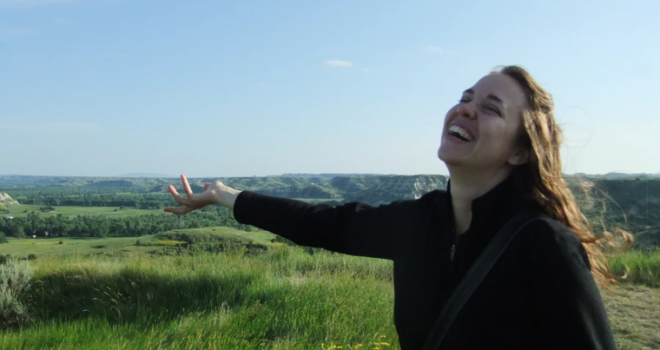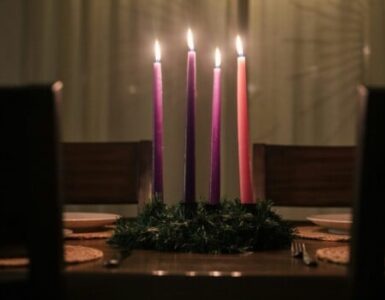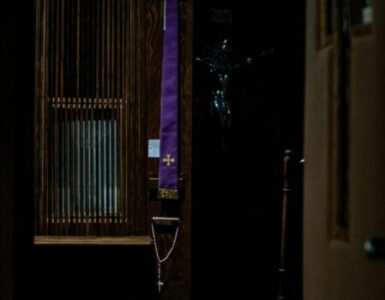Michelle Duppong’s life might not have made national headlines, but her quiet witness of faith reveals a path to holiness accessible to everyone—a message echoed in the life and writings of St. Thérèse of Lisieux.
I was recently invited to watch the limited screening of Radiating Joy: The Michelle Duppong Story along with some of my classmates. In watching the film, I couldn’t help but be reminded of the great spiritual writing of Therese of Lisieux. It is in her life and her three-manuscript collection, The Story of a Soul, that she very much serves as a precursor towards the life and spirituality that Michelle would live and share.
By secular world accounts, Michelle didn’t live a very extraordinary life. Sure, most people would know her to be a great person who was loving, but in a material world that only lasts so long. However, she still probably would not land amongst the most notable Catholics. This woman was not Jeanne d’Arc. She was not Mother Teresa. She was not Catherine of Siena. She was Michelle Christine Duppong. Certainly, she was no commander challenging Earl Thomas Montagu or arbitrator standing before Pope Gregory XI.
In the decades since their foundation, FOCUS has called thousands of missionaries. Prima fascia Michelle might appear to be one soul amongst many. She might appear to have lived a life like thousands, if not tens or hundreds of thousands of others.
This is precisely what is beautiful. I can state unequivocally that those reading this article will not live lives like the earlier mentioned women. No one reading this article will be a military commander, a Nobel Peace Prize Winner, or a Doctor of the Church. However, we all hope for Heaven. This is part of the witness of Michelle.
She was a simple daughter amongst six children. She attended North Dakota State University, earning a Bachelor of Science Degree in Horticulture. As was referenced in the film, she did not earn any degrees in theology from the Gregorian or Harvard or Louvain. She attended the small country church of Saint Clement in Morton County. She loved to pick flowers, to work in vineyards, and climb hay bales (Legacy). In many ways she might challenge our understanding of the saints; you could imagine her simply being any other mid-western friend of yours. This is precisely the message expressed in the final moments of the film, when one of her friends remarks how amazing it is that she knew someone who might be a saint.
To reference her former team director, Mark Bartek, “She deeply desired to see everyone grow into saints. And she believed deeply that the call to holiness was not some kind of superficial thing, only for the few” (EquipCast 37:52). This, I believe, was the crux of the film. One might be under the false impression that Michelle was one unsignificant rose amongst many in the fields of the Lord. This was the heresy which Therse of Lisieux challenged. To be called to the grove of the Lord, we are not necessarily called to be extraordinary figures in the Church, but rather what He calls. In the case of Michelle, it was a missionary and a witness in suffering.
For most of her professional life, her proverbial battlefields were college campuses. It wasn’t until the end of her life that her battle shifted towards a painful sickness. Of course her greatest witness towards the faith was that of her last year on this earth. In 2014 she was diagnosed with stage four colon cancer and was given two months to live. As the great prologue of John emphatically states, “The light shines in the darkness, and the darkness has not overcome it” (John 1:5 NIV).
Those familiar with the life of the Little Flower will no doubt draw parallel. This was the great witness of these two holy women. Near the end of their lives, both women were given the devastating news of their own mortality. However, both took these grave diagnoses in great strength and resilience.
At one point in the film, the Duppong family told the story about how tubes had been placed between her ribs at that point where every breath was one of excruciating pain. No doubt the spear in the ribs of Jesus would have been apparent. Yet, her pain was not something that allowed her to lash out or loath in self-pity. Rather, her doctor, Leo Taiberg, recounted a story that upon removing her morphine drip to save her life, he was greeted not with scorn, anger, or self-obsession, but with a simple “How are you?”
Both women bore their cross of a painful death at a young age. Despite great suffering, their humility and love bore through. It was in Duppong’s pain and suffering that she brought light to the dying children of the hospital and to the lost and stirring souls of the community.
On the bus ride back to campus, one of my friends asked if she was a “martyr.” Certainly my friend was confused on the colloquial understanding of the word. However, she wasn’t wrong. Michelle was a witness—the root of the word martyr.
It is in the writings of St. Therese that the great Doctor amoris applies the term “martyrdom” to redemptive suffering. It was in Michelle’s struggles, such as scrupulousness, that she applied her martyrdom by lifting up her sorrows to God. It was the knowledge of her foreboding death from cancer, the knowledge that, if she were to live, her life would be different, the knowledge she would not have kids.
This was the great mystery of Michelle. In her excruciating pain and confusion, the moment which would have been the time to cry out, “My God, my God, why have you forsaken me,” she found herself bringing her hurt and sorrow to the Lord. She proclaimed, “But you, LORD, do not be far from me. You are my strength; come quickly to help me.” It was according to her great friend, Monsignor James Shea, that she was one “who accepted, with serenity, both the joys and suffering of her life. Michelle never forgot about the power of redemptive suffering” (NCR). It was in the twelve months of painful and unimaginable suffering that she brought them to the Lord, not for herself, but for the conversion of souls.
It was near the last moments of her life that one of the most powerful instances of her love was exhibited. Renae Duppong, her sister who served as her personal nurse, tells this story. By this point it had become clear that treatment was not going to work, and Michelle was brought to the farm to spend the rest of her few days at her home. By virtue of her illness, she had grown immensely weak and spent most of her time in the home. However, it was her act of strength, challenging her sister’s recommendation to remain in bed, that she protested, “I want to go to Mass today. I want to see Jesus.”
The devotion that Michelle had cannot be ignored. It was said that in the first half of holy hours Michelle could not be found, not because she was skipping out, but because she was bowed down before the Lord. Both Duppong and St. Therese brought their suffering, pain, and sickness to the hands of The Great Physician. It was in the face of death that neither woman lost their hope in the Source of Life.
This article should not be seen in any way as dismissive of Michelle and her struggle; rather, this article is one of praise. I would find myself blessed to live a life half as holy and abundant as hers. Michelle reminds us that, although we might be amongst the countless flowers that are FOCUS missionaries, farmers, diocesan employees, or college students, we have hope of being picked and cherished by Jesus for His own.

One is reminded of Carlo Dolci’s The Infant Christ with a Floral Wreath (pictured above), where Our Lord holds flowers some similar, some different. That is the communion of Saints. This is the message of her life. Michelle gives us hope, guidance, and knowledge of this Divine love.
Photo from FOCUS Catholic












